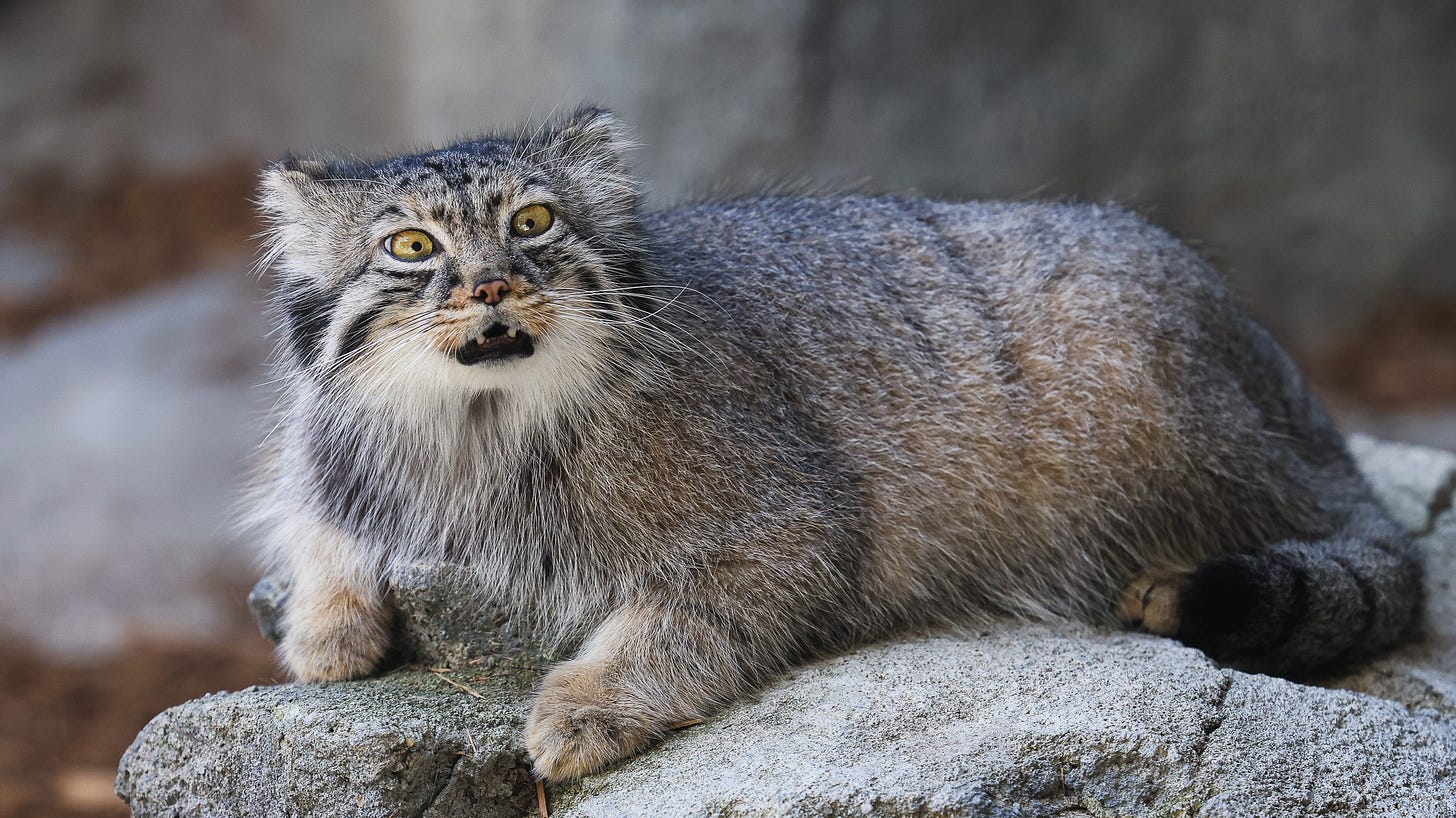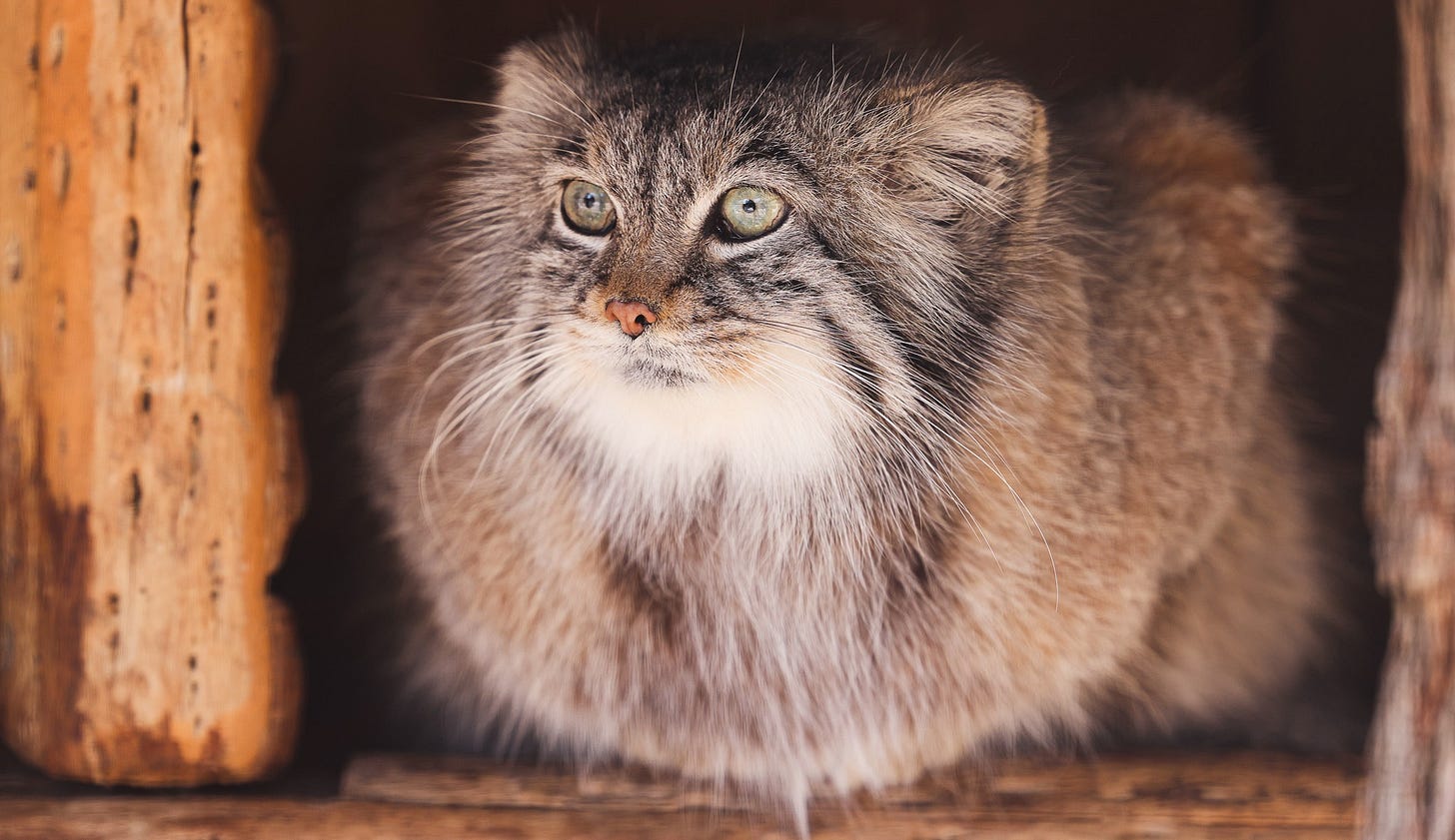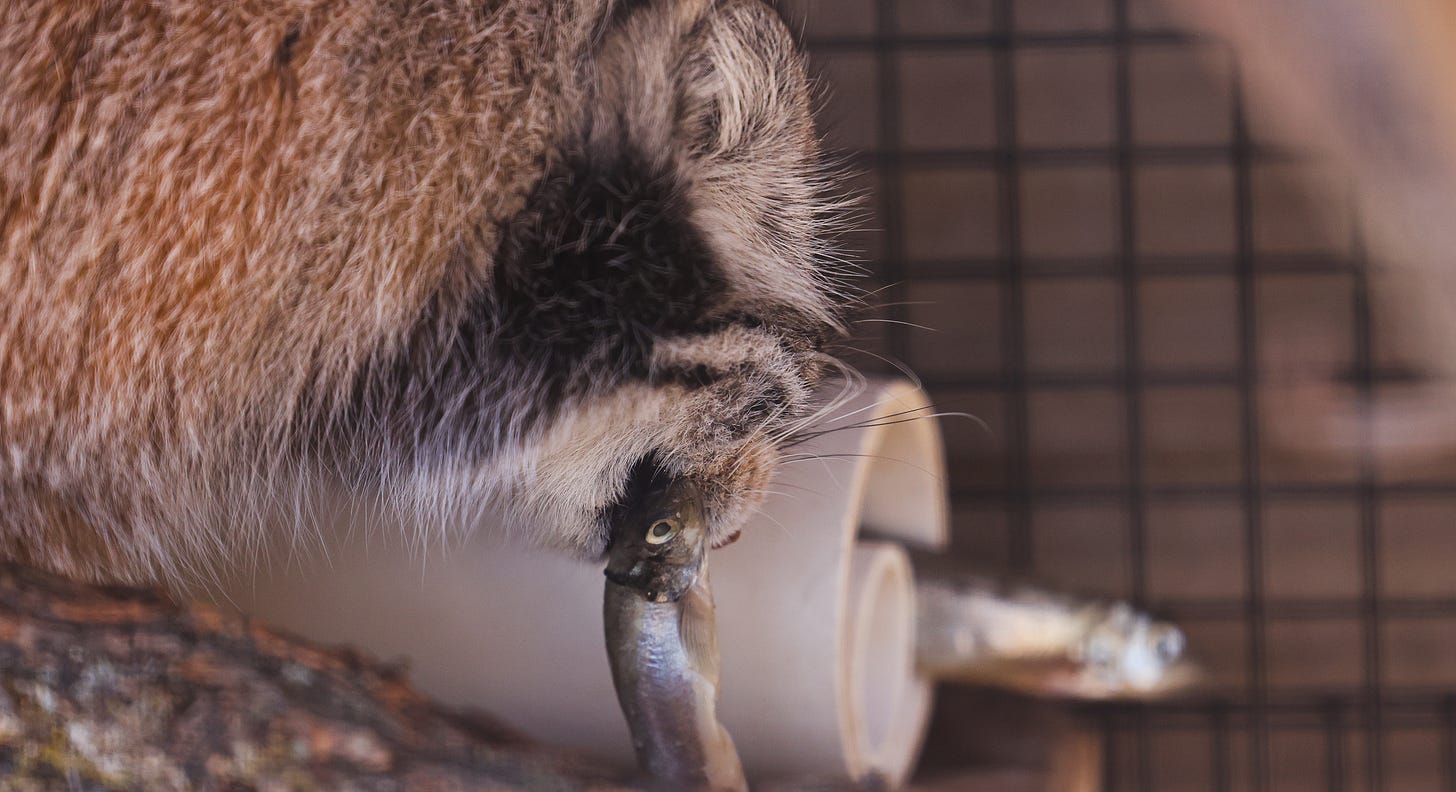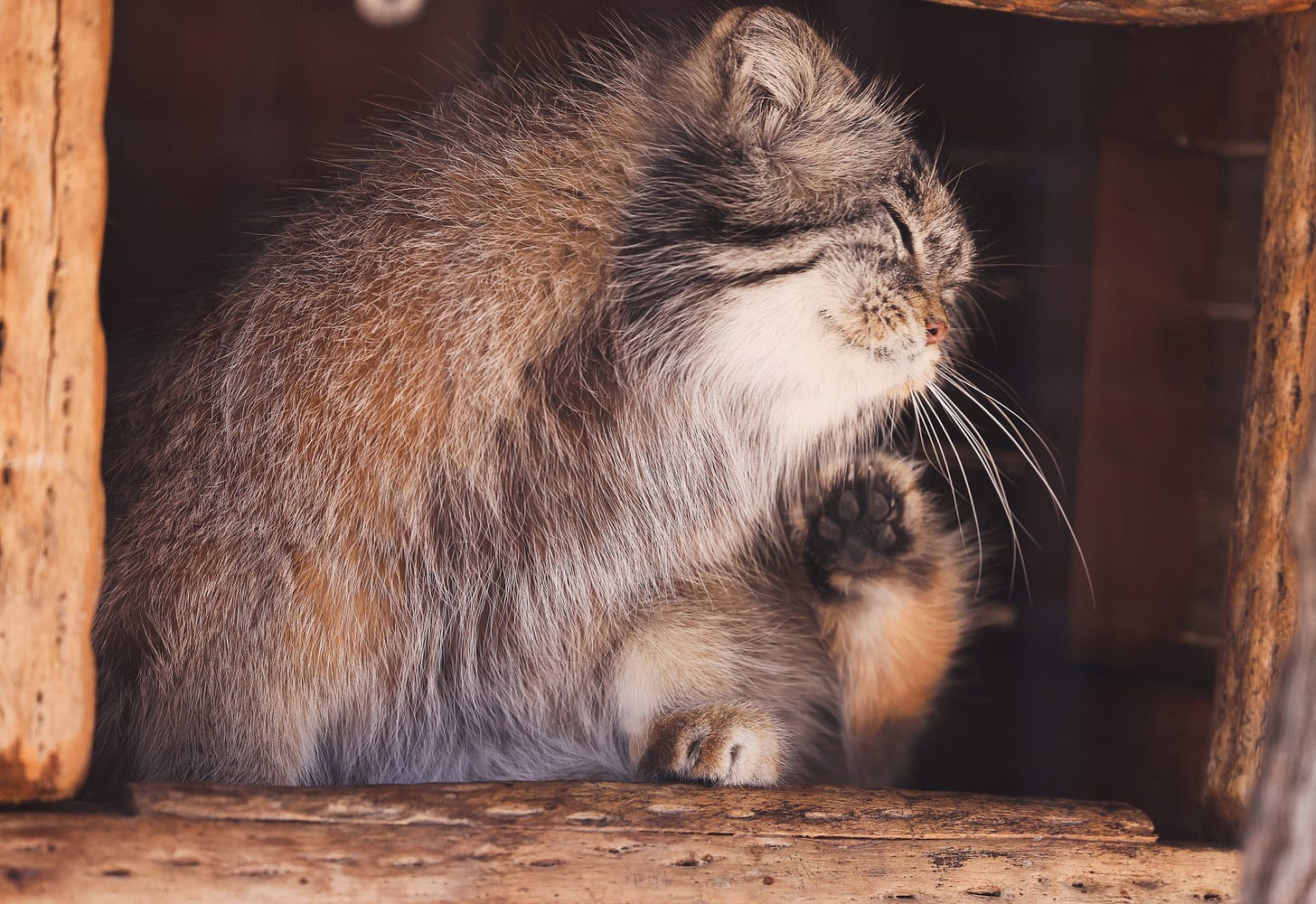A visit to Miller Park Zoo took an surprising turn when I witnessed something I'd never seen before — a female manul honking. Nozomi, an older and typically reserved manul, suddenly let out a territorial vocalization (that I refer to as honking) that left me stunned. But before we get into that, let me set the scene.
Last week, on International Women’s Day, I took a road trip out to Miller Park Zoo in Bloomington, Illinois, to visit the beautiful Nozomi. Truth be told, it had been a while since my last “Pallas Pilgrimage” — several months, actually! So while I was eager for the adventure, I was also feeling pretty rusty with the camera.
I set up right in front of her enclosure, where she was perched in a high-up roosting box, watching the sparse trickle of visitors arriving right at zoo opening. After a while she decided to take a little stroll. With dexterity, she hopped down, making her way along the suspended branches before reaching the ground. She marched the perimeter of her domain, inspecting every corner with utmost authority. Then, just as effortlessly, she climbed all the way back up to her box, nestled in, and let out a deep, satisfying yawn.
And then — something I never expected.
HONKS.
I was stunned. My hands, jittery with excitement, barely kept the camera steady. Did Nozomi just… honk?
A few minutes later, she did it again.
Wait — female manuls honk?
I’ve heard my fair share of manul honks, but they’ve almost always come from the males. Pazi, for example, is a notorious honker. The four brothers at Ross Park Zoo express themselves with all kinds of honk-like vocalizations. And of course, there’s the honking hall of fame: Bol, Lev, Grusha, Lotus, and El — the famous Japanese male manuls frequently caught on camera making their territorial calls.
Now, I have seen females honk before — kind of. Tiina, a mother at Columbus Zoo, would sometimes let out honk-like sounds, usually in moments of frustration or while barking orders at her kittens (the troublemakers), Meera and Goose. But those vocalizations were different. They weren’t the same repetitive, deep, territorial honks that I’ve seen male manuls use (presumably) to proclaim their turf.

But Nozomi? Nozomi was honking like any male that I’ve seen. She called out with the same confidence I’ve seen in Pazi, as if declaring to the red wolves in the neighboring exhibit: “This is my turf. Stay over there!”.
I asked her keepers if they had heard her do this before. They hadn’t. But in my experience that isn’t uncommon — keepers often see their animals in a different context. Manuls are very smart, and behave differently when they know their keepers are nearby (usually because they associate them with food).
Either way, this observation seemed significant.
While I’ve generally interpreted repetitive honks as territorial calls, the truth is we don’t fully understand the exact meaning behind these vocalizations. They could signify territorial claims, excitement, or even serve as mating calls. It seems there’s still much left to decipher about the language of manuls.
This pilgrimage was another one for the books. Not only did I get some great content, but I also got to reunite with a truly special manul. Nozomi reminded me, once again, that no matter how many manuls I visit — and whether for the first time or the tenth — there’s always something new to observe. And that’s what keeps this obsession as exciting today as it was on day one.
Meet Nozomi: A matriarch of hope
She’s 7 years old, coming up on 8 next month. This lovely mama-manul (mamanul?) was given the name Nozomi (のぞみ), meaning “hope” in Japanese. And fittingly, she represents the hope of the U.S. manul breeding program. Nozomi is the daughter of Sural (サーラル), a Japanese manul descended from the legendary matriarch Tabby. That means she carries the Japanese lineage, linking many U.S. manuls to Tabby’s bloodline.
In 2019, Nozomi and a Czech-born manul named Misha, had a litter of five kittens: Ruby, Jodi, Moose, Dean, and Collins. Two of her kittens, Moose and Jodi, have gone on to have their own litters, making Nozomi a grandmanul — and Tabby a great-great-grandmanul before her passing this year. If you’ve been keeping up with my recent Instagram posts, you’ve probably even seen Nozomi’s grandchildren, Meera and Goose, getting into all sorts of trouble.
One of Nozomi’s keepers described her as shy, with a knack for serving judgmental looks. I can confirm that! Even when receiving some special enrichment snacks, she remained reserved and cautious — a stark contrast to Pazi, who would’ve been going absolutely feral at the mere thought of food. But don’t let her quiet nature fool you — Nozomi is spry. She moves gracefully, navigating her habitat with ease, jumping up and down with the same agility as any other manul.
Her preferred enrichment? Fish. She devoured those first, without hesitation, confirming them as the clear favorite. She also received a mouse and some meatballs, which she took her time with, as if carefully considering each bite.
So, what do I make of Nozomi’s honks?
Are female manuls just more vocal than we realize? Was she simply in a rare honking mood? Or perhaps it’s just that males have taken the spotlight when it comes to vocalizations. I’m not exactly sure. One thing is for certain — manuls continue to surprise me, even after all these years. Oh, and if you ever find yourself in Bloomington, Illinois, I highly recommend a visit to Miller Park Zoo to meet Nozomi for yourself. Who knows — she might even greet you with some honks!
Thank you for your support!
I want to take a moment to extend my deepest gratitude to all of my paid subscribers. Your support goes towards conserving these lovely animals in the wild — but it also made this very pilgrimage possible. A portion of the proceeds I received in February helped cover this journey to see Nozomi.
I don’t get monetization from my work posted on Instagram or anywhere else. This Substack is the only way I fund my photography, travel, and research on manuls. Every subscription helps me continue sharing these stories, capturing new content, and — most importantly — supporting the conservation of manuls. At the end of March, I’ll post an update about the money raised so far, along with my first contributions to conservation organizations and to Potter Park Zoo’s Pazi.
If you’d like to support my work — even just for a month — it truly makes a difference. Every contribution helps me create more content and supports the manul cause. And of course, if you subscribe, you’ll also gain access to my exclusive Friday Features with bonus content!
Thank you for being a part of this journey 🐾 💖







this newsletter always leaves a smile on my face. thank you for creating this newsletter. here's to many more manul pilgrimmages!
Wake up new manul Monday newsletter just dropped 😻 very interesting read and stunning photos